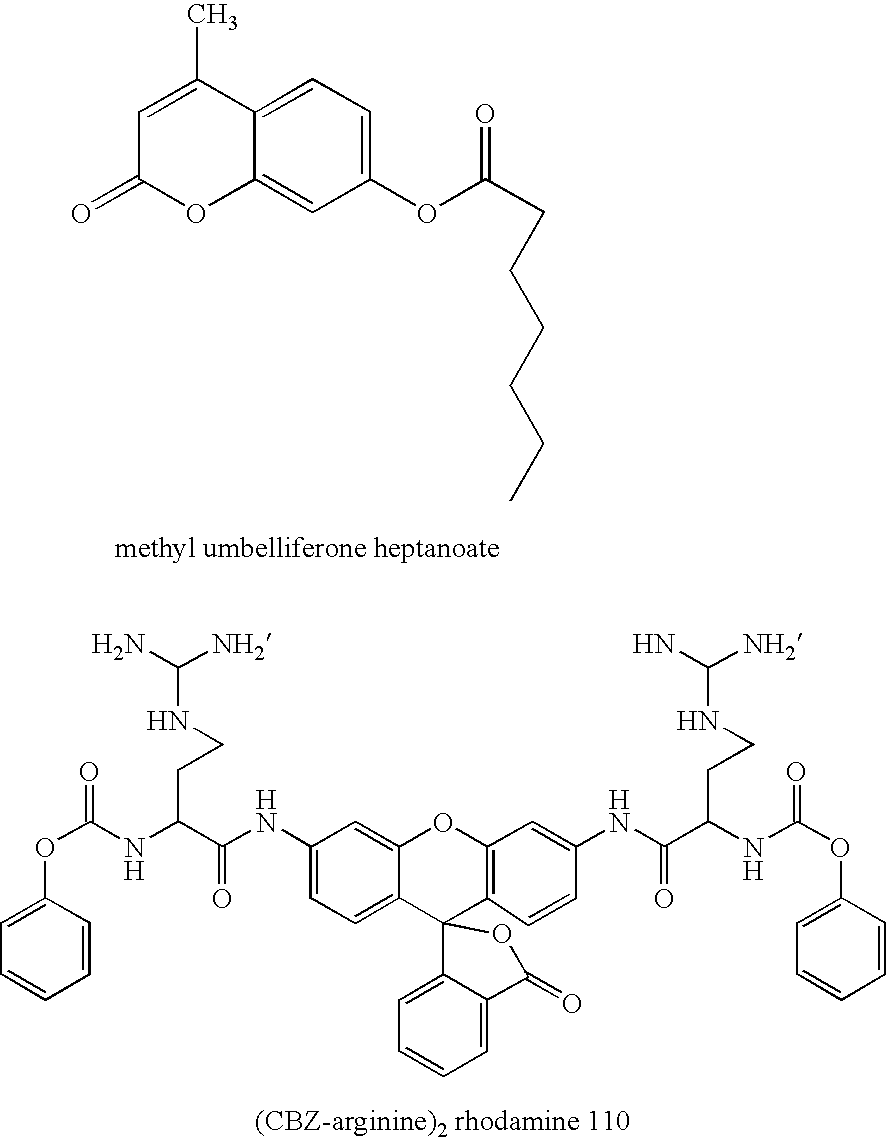Screening methods and libraries of trace amounts of DNA from uncultivated microorganisms
- Summary
- Abstract
- Description
- Claims
- Application Information
AI Technical Summary
Benefits of technology
Problems solved by technology
Method used
Image
Examples
example 1
DNA Isolation and Library Construction
[0279] The following outlines the procedures used to generate a gene library from a mixed population of organisms.
[0280] DNA isolation. DNA is isolated using the IsoQuick Procedure as per manufacturer's instructions (Orca, Research Inc., Bothell, Wash.). DNA can be normalized according to Example 2 below. Upon isolation the DNA is sheared by pushing and pulling the DNA through a 25G double-hub needle and a 1-cc syringes about 500 times. A small amount is run on a 0.8% agarose gel to make sure the majority of the DNA is in the desired size range (about 3-6 kb).
[0281] Blunt-ending DNA. The DNA is blunt-ended by mixing 45 ul of 10× Mung Bean Buffer, 2.0 ul Mung Bean Nuclease (150 u / ul) and water to a final volume of 405 ul. The mixture is incubate at 370C for 15 minutes. The mixture is phenol / chloroform extracted followed by an additional chloroform extraction. One ml of ice cold ethanol is added to the final extract to precipitate the DNA. The ...
example 2
Enzymatic Activity Assay
[0293] The following is a representative example of a procedure for screening an expression library prepared in accordance with Example 1. In the following, the chemical characteristic Tiers are as follows: [0294] Tier 1: Hydrolase [0295] Tier 2: Amide, Ester and Acetal [0296] Tier 3: Divisions and subdivisions are based upon the differences between individual substrates that are covalently attached to the functionality of Tier 2 undergoing reaction; as well as substrate specificity. [0297] Tier 4: The two possible enantiomeric products which the protein, e.g. enzyme, may produce from a substrate.
[0298] Although the following example is specifically directed to the above-mentioned tiers, the general procedures for testing for various chemical characteristics is generally applicable to substrates other than those specifically referred to in this Example.
[0299] Screening for Tier 1-hydrolase; Tier 2-amide. Plates of the library prepared as described in Examp...
example 3
Construction of a Stable, Large Insert Picoplankton Genomic DNA Library
[0310]FIG. 5 shows an overview of the procedures used to construct an environmental library from a mixed picoplankton sample. A stable, large insert DNA library representing picoplankton genomic DNA was prepared as follows.
[0311] Cell collection and preparation of DNA. Agarose plugs containing concentrated picoplankton cells were prepared from samples collected on an oceanographic cruise from Newport, Oreg. to Honolulu, Hi. Seawater (30 liters) was collected in Niskin bottles, screened through 10 μm Nitex, and concentrated by hollow fiber filtration (Amicon DC10) through 30,000 MW cutoff polyfulfone filters. The concentrated bacterioplankton cells were collected on a 0.22 11m, 47 mm Durapore filter, and resuspended in 1 ml of 2×STE buffer (1M NaCl, 0.1M EDTA, 10 mM Tris, pH 8.0) to a final density of approximately 1×1010 cells per ml. The cell suspension was mixed with one volume of 1% molten Seaplaque LMP agar...
PUM
| Property | Measurement | Unit |
|---|---|---|
| Temperature | aaaaa | aaaaa |
| Temperature | aaaaa | aaaaa |
| Temperature | aaaaa | aaaaa |
Abstract
Description
Claims
Application Information
 Login to View More
Login to View More - R&D
- Intellectual Property
- Life Sciences
- Materials
- Tech Scout
- Unparalleled Data Quality
- Higher Quality Content
- 60% Fewer Hallucinations
Browse by: Latest US Patents, China's latest patents, Technical Efficacy Thesaurus, Application Domain, Technology Topic, Popular Technical Reports.
© 2025 PatSnap. All rights reserved.Legal|Privacy policy|Modern Slavery Act Transparency Statement|Sitemap|About US| Contact US: help@patsnap.com



